Healthcare Ethics: Analysis of Ethical Issues in a Healthcare Setting
VerifiedAdded on 2021/05/31
|8
|2003
|115
Essay
AI Summary
This essay delves into the complex realm of healthcare ethics, using the case of Amos to dissect various ethical issues. The analysis identifies violations of human rights, discrimination, and disregard for human dignity. It examines the ethical implications of the healthcare professionals' actions, particularly concerning the principles of autonomy, justice, beneficence, and non-maleficence. The essay highlights the importance of the Nursing and Midwifery Board of Australia's code of professional conduct, emphasizing the need for reflective and ethical practice. The author then provides recommendations for improved professional conduct, suggesting alternative interventions such as patient education and referral strategies to mitigate ethical dilemmas in healthcare settings. The essay concludes by reiterating the significance of ethical considerations in contemporary society and healthcare.
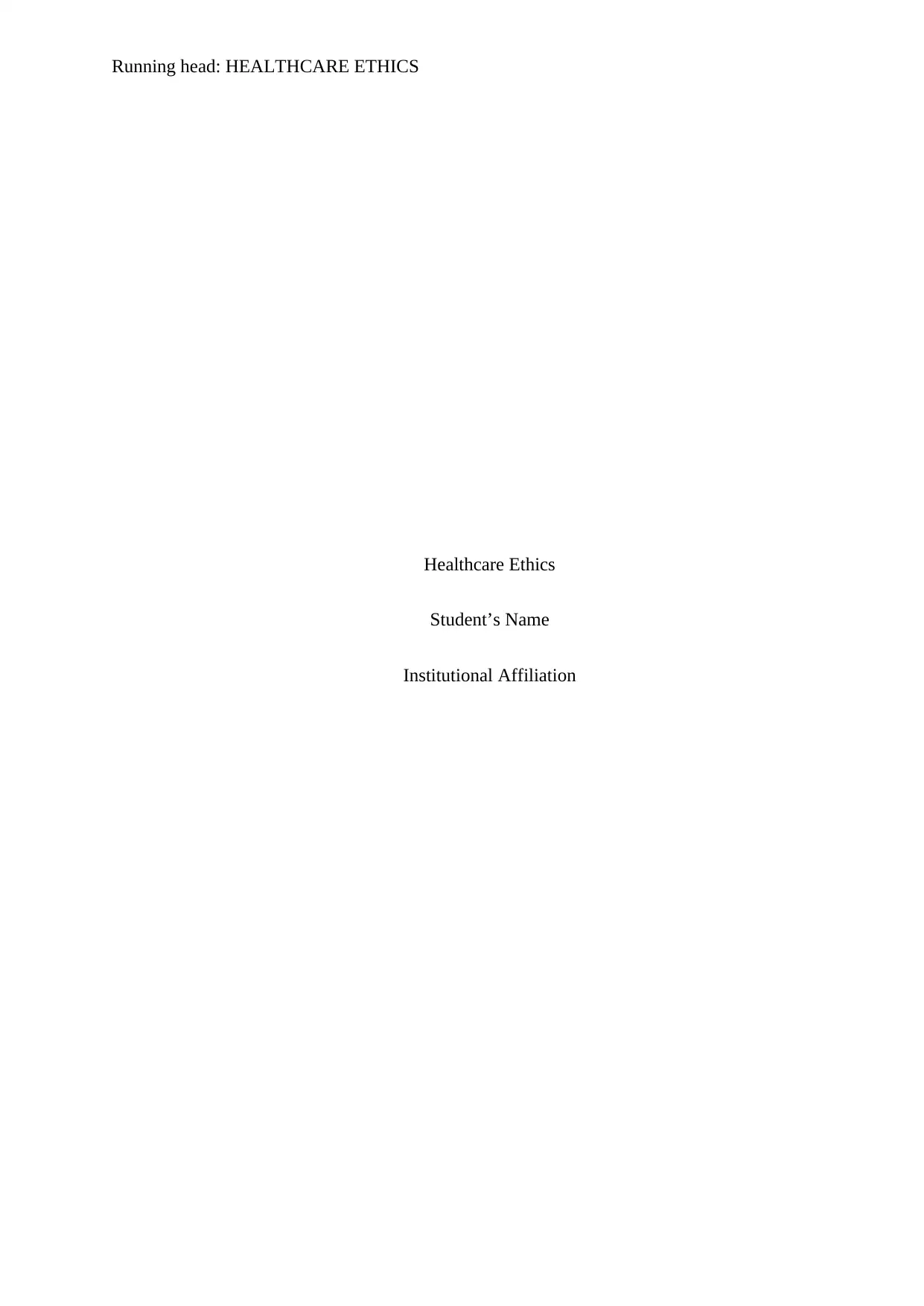
Running head: HEALTHCARE ETHICS
Healthcare Ethics
Student’s Name
Institutional Affiliation
Healthcare Ethics
Student’s Name
Institutional Affiliation
Paraphrase This Document
Need a fresh take? Get an instant paraphrase of this document with our AI Paraphraser
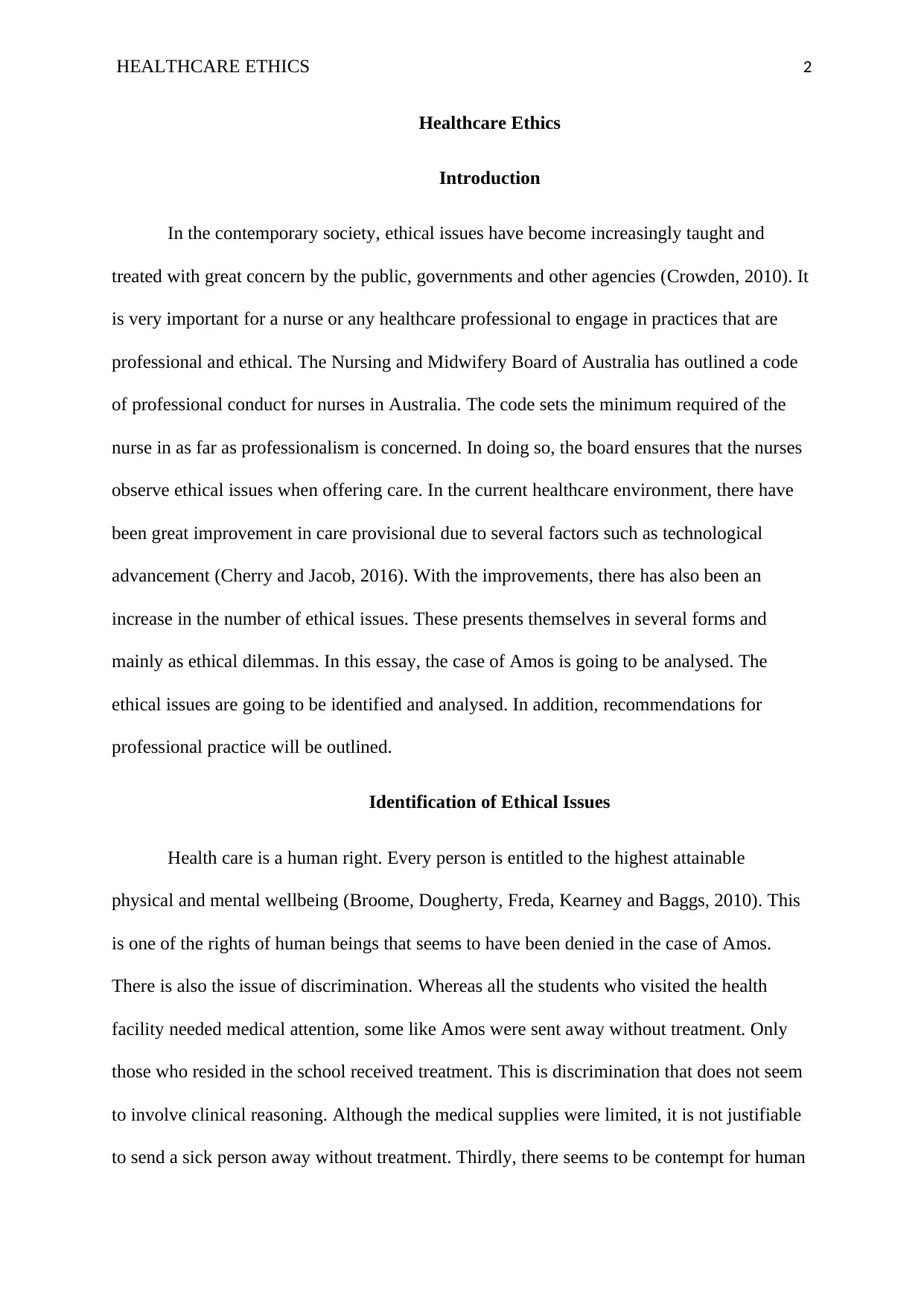
HEALTHCARE ETHICS 2
Healthcare Ethics
Introduction
In the contemporary society, ethical issues have become increasingly taught and
treated with great concern by the public, governments and other agencies (Crowden, 2010). It
is very important for a nurse or any healthcare professional to engage in practices that are
professional and ethical. The Nursing and Midwifery Board of Australia has outlined a code
of professional conduct for nurses in Australia. The code sets the minimum required of the
nurse in as far as professionalism is concerned. In doing so, the board ensures that the nurses
observe ethical issues when offering care. In the current healthcare environment, there have
been great improvement in care provisional due to several factors such as technological
advancement (Cherry and Jacob, 2016). With the improvements, there has also been an
increase in the number of ethical issues. These presents themselves in several forms and
mainly as ethical dilemmas. In this essay, the case of Amos is going to be analysed. The
ethical issues are going to be identified and analysed. In addition, recommendations for
professional practice will be outlined.
Identification of Ethical Issues
Health care is a human right. Every person is entitled to the highest attainable
physical and mental wellbeing (Broome, Dougherty, Freda, Kearney and Baggs, 2010). This
is one of the rights of human beings that seems to have been denied in the case of Amos.
There is also the issue of discrimination. Whereas all the students who visited the health
facility needed medical attention, some like Amos were sent away without treatment. Only
those who resided in the school received treatment. This is discrimination that does not seem
to involve clinical reasoning. Although the medical supplies were limited, it is not justifiable
to send a sick person away without treatment. Thirdly, there seems to be contempt for human
Healthcare Ethics
Introduction
In the contemporary society, ethical issues have become increasingly taught and
treated with great concern by the public, governments and other agencies (Crowden, 2010). It
is very important for a nurse or any healthcare professional to engage in practices that are
professional and ethical. The Nursing and Midwifery Board of Australia has outlined a code
of professional conduct for nurses in Australia. The code sets the minimum required of the
nurse in as far as professionalism is concerned. In doing so, the board ensures that the nurses
observe ethical issues when offering care. In the current healthcare environment, there have
been great improvement in care provisional due to several factors such as technological
advancement (Cherry and Jacob, 2016). With the improvements, there has also been an
increase in the number of ethical issues. These presents themselves in several forms and
mainly as ethical dilemmas. In this essay, the case of Amos is going to be analysed. The
ethical issues are going to be identified and analysed. In addition, recommendations for
professional practice will be outlined.
Identification of Ethical Issues
Health care is a human right. Every person is entitled to the highest attainable
physical and mental wellbeing (Broome, Dougherty, Freda, Kearney and Baggs, 2010). This
is one of the rights of human beings that seems to have been denied in the case of Amos.
There is also the issue of discrimination. Whereas all the students who visited the health
facility needed medical attention, some like Amos were sent away without treatment. Only
those who resided in the school received treatment. This is discrimination that does not seem
to involve clinical reasoning. Although the medical supplies were limited, it is not justifiable
to send a sick person away without treatment. Thirdly, there seems to be contempt for human
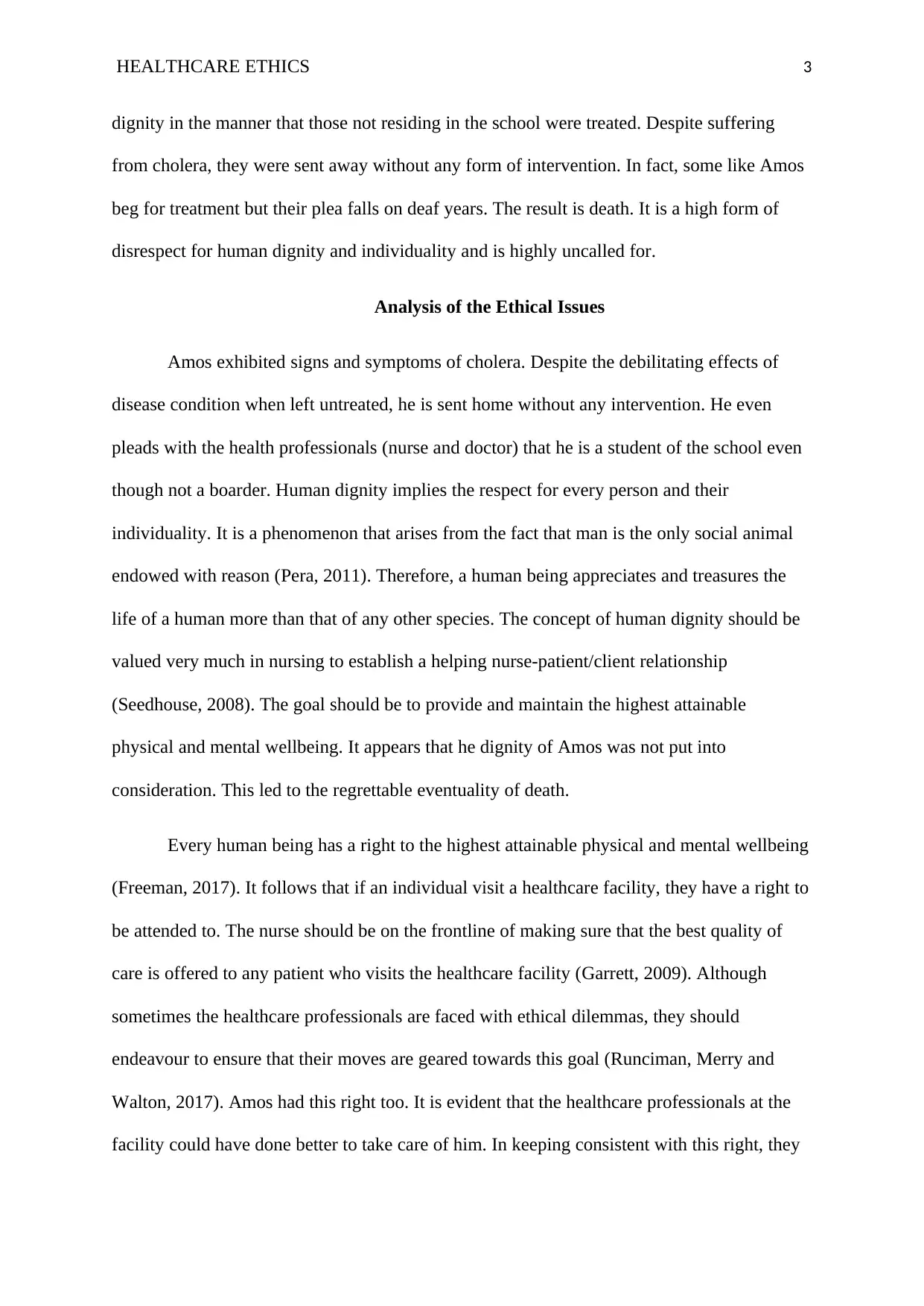
HEALTHCARE ETHICS 3
dignity in the manner that those not residing in the school were treated. Despite suffering
from cholera, they were sent away without any form of intervention. In fact, some like Amos
beg for treatment but their plea falls on deaf years. The result is death. It is a high form of
disrespect for human dignity and individuality and is highly uncalled for.
Analysis of the Ethical Issues
Amos exhibited signs and symptoms of cholera. Despite the debilitating effects of
disease condition when left untreated, he is sent home without any intervention. He even
pleads with the health professionals (nurse and doctor) that he is a student of the school even
though not a boarder. Human dignity implies the respect for every person and their
individuality. It is a phenomenon that arises from the fact that man is the only social animal
endowed with reason (Pera, 2011). Therefore, a human being appreciates and treasures the
life of a human more than that of any other species. The concept of human dignity should be
valued very much in nursing to establish a helping nurse-patient/client relationship
(Seedhouse, 2008). The goal should be to provide and maintain the highest attainable
physical and mental wellbeing. It appears that he dignity of Amos was not put into
consideration. This led to the regrettable eventuality of death.
Every human being has a right to the highest attainable physical and mental wellbeing
(Freeman, 2017). It follows that if an individual visit a healthcare facility, they have a right to
be attended to. The nurse should be on the frontline of making sure that the best quality of
care is offered to any patient who visits the healthcare facility (Garrett, 2009). Although
sometimes the healthcare professionals are faced with ethical dilemmas, they should
endeavour to ensure that their moves are geared towards this goal (Runciman, Merry and
Walton, 2017). Amos had this right too. It is evident that the healthcare professionals at the
facility could have done better to take care of him. In keeping consistent with this right, they
dignity in the manner that those not residing in the school were treated. Despite suffering
from cholera, they were sent away without any form of intervention. In fact, some like Amos
beg for treatment but their plea falls on deaf years. The result is death. It is a high form of
disrespect for human dignity and individuality and is highly uncalled for.
Analysis of the Ethical Issues
Amos exhibited signs and symptoms of cholera. Despite the debilitating effects of
disease condition when left untreated, he is sent home without any intervention. He even
pleads with the health professionals (nurse and doctor) that he is a student of the school even
though not a boarder. Human dignity implies the respect for every person and their
individuality. It is a phenomenon that arises from the fact that man is the only social animal
endowed with reason (Pera, 2011). Therefore, a human being appreciates and treasures the
life of a human more than that of any other species. The concept of human dignity should be
valued very much in nursing to establish a helping nurse-patient/client relationship
(Seedhouse, 2008). The goal should be to provide and maintain the highest attainable
physical and mental wellbeing. It appears that he dignity of Amos was not put into
consideration. This led to the regrettable eventuality of death.
Every human being has a right to the highest attainable physical and mental wellbeing
(Freeman, 2017). It follows that if an individual visit a healthcare facility, they have a right to
be attended to. The nurse should be on the frontline of making sure that the best quality of
care is offered to any patient who visits the healthcare facility (Garrett, 2009). Although
sometimes the healthcare professionals are faced with ethical dilemmas, they should
endeavour to ensure that their moves are geared towards this goal (Runciman, Merry and
Walton, 2017). Amos had this right too. It is evident that the healthcare professionals at the
facility could have done better to take care of him. In keeping consistent with this right, they
⊘ This is a preview!⊘
Do you want full access?
Subscribe today to unlock all pages.

Trusted by 1+ million students worldwide
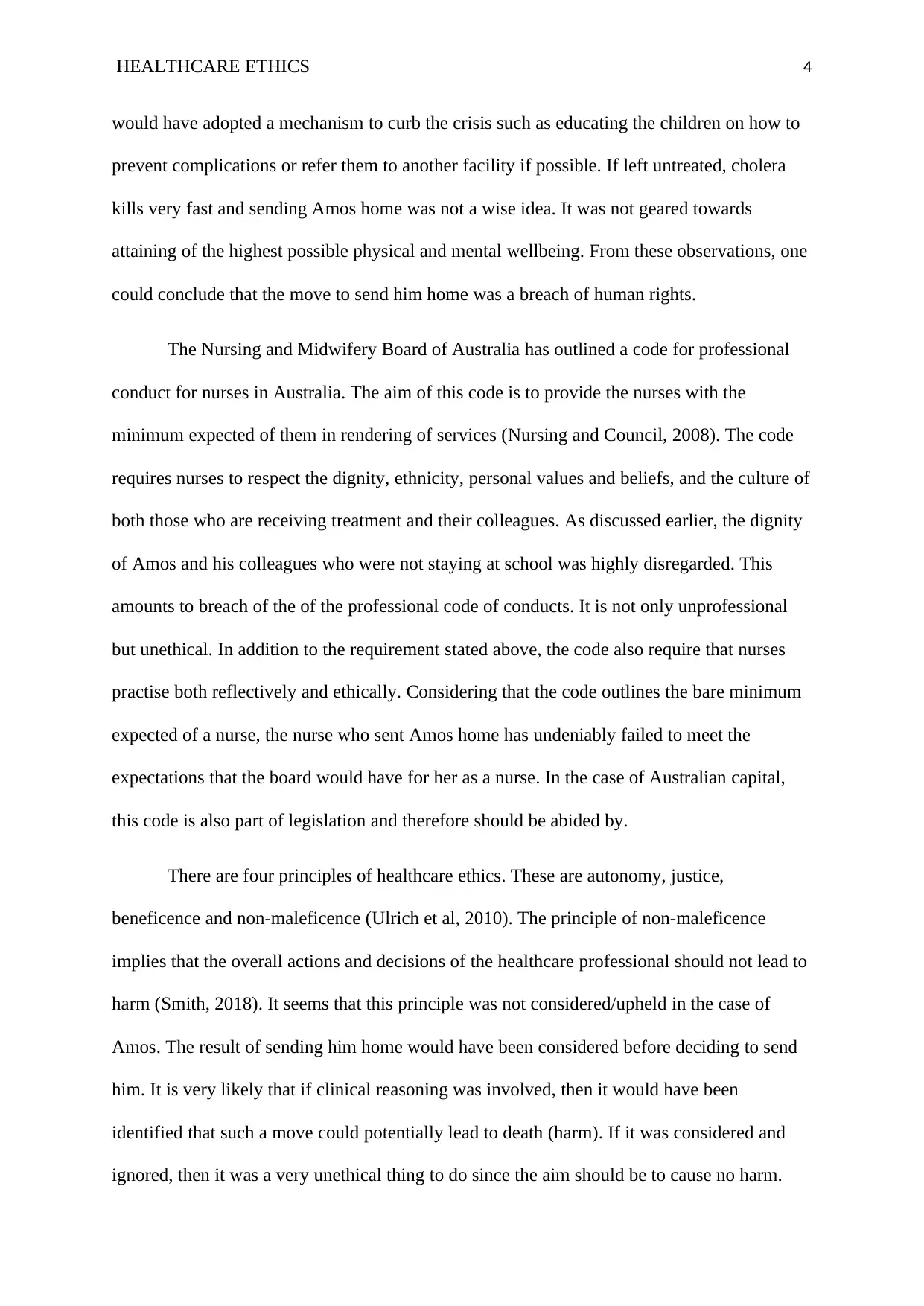
HEALTHCARE ETHICS 4
would have adopted a mechanism to curb the crisis such as educating the children on how to
prevent complications or refer them to another facility if possible. If left untreated, cholera
kills very fast and sending Amos home was not a wise idea. It was not geared towards
attaining of the highest possible physical and mental wellbeing. From these observations, one
could conclude that the move to send him home was a breach of human rights.
The Nursing and Midwifery Board of Australia has outlined a code for professional
conduct for nurses in Australia. The aim of this code is to provide the nurses with the
minimum expected of them in rendering of services (Nursing and Council, 2008). The code
requires nurses to respect the dignity, ethnicity, personal values and beliefs, and the culture of
both those who are receiving treatment and their colleagues. As discussed earlier, the dignity
of Amos and his colleagues who were not staying at school was highly disregarded. This
amounts to breach of the of the professional code of conducts. It is not only unprofessional
but unethical. In addition to the requirement stated above, the code also require that nurses
practise both reflectively and ethically. Considering that the code outlines the bare minimum
expected of a nurse, the nurse who sent Amos home has undeniably failed to meet the
expectations that the board would have for her as a nurse. In the case of Australian capital,
this code is also part of legislation and therefore should be abided by.
There are four principles of healthcare ethics. These are autonomy, justice,
beneficence and non-maleficence (Ulrich et al, 2010). The principle of non-maleficence
implies that the overall actions and decisions of the healthcare professional should not lead to
harm (Smith, 2018). It seems that this principle was not considered/upheld in the case of
Amos. The result of sending him home would have been considered before deciding to send
him. It is very likely that if clinical reasoning was involved, then it would have been
identified that such a move could potentially lead to death (harm). If it was considered and
ignored, then it was a very unethical thing to do since the aim should be to cause no harm.
would have adopted a mechanism to curb the crisis such as educating the children on how to
prevent complications or refer them to another facility if possible. If left untreated, cholera
kills very fast and sending Amos home was not a wise idea. It was not geared towards
attaining of the highest possible physical and mental wellbeing. From these observations, one
could conclude that the move to send him home was a breach of human rights.
The Nursing and Midwifery Board of Australia has outlined a code for professional
conduct for nurses in Australia. The aim of this code is to provide the nurses with the
minimum expected of them in rendering of services (Nursing and Council, 2008). The code
requires nurses to respect the dignity, ethnicity, personal values and beliefs, and the culture of
both those who are receiving treatment and their colleagues. As discussed earlier, the dignity
of Amos and his colleagues who were not staying at school was highly disregarded. This
amounts to breach of the of the professional code of conducts. It is not only unprofessional
but unethical. In addition to the requirement stated above, the code also require that nurses
practise both reflectively and ethically. Considering that the code outlines the bare minimum
expected of a nurse, the nurse who sent Amos home has undeniably failed to meet the
expectations that the board would have for her as a nurse. In the case of Australian capital,
this code is also part of legislation and therefore should be abided by.
There are four principles of healthcare ethics. These are autonomy, justice,
beneficence and non-maleficence (Ulrich et al, 2010). The principle of non-maleficence
implies that the overall actions and decisions of the healthcare professional should not lead to
harm (Smith, 2018). It seems that this principle was not considered/upheld in the case of
Amos. The result of sending him home would have been considered before deciding to send
him. It is very likely that if clinical reasoning was involved, then it would have been
identified that such a move could potentially lead to death (harm). If it was considered and
ignored, then it was a very unethical thing to do since the aim should be to cause no harm.
Paraphrase This Document
Need a fresh take? Get an instant paraphrase of this document with our AI Paraphraser
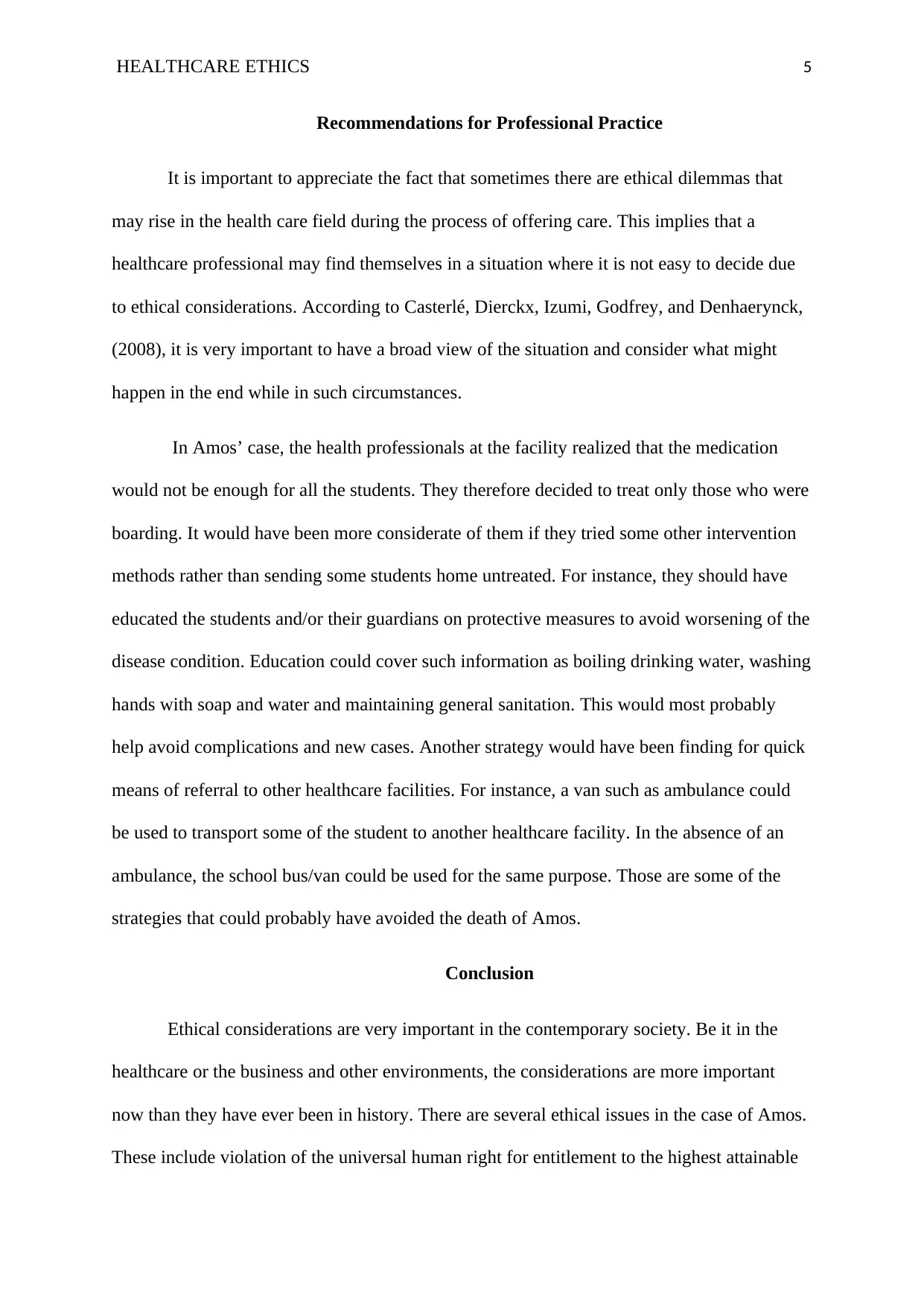
HEALTHCARE ETHICS 5
Recommendations for Professional Practice
It is important to appreciate the fact that sometimes there are ethical dilemmas that
may rise in the health care field during the process of offering care. This implies that a
healthcare professional may find themselves in a situation where it is not easy to decide due
to ethical considerations. According to Casterlé, Dierckx, Izumi, Godfrey, and Denhaerynck,
(2008), it is very important to have a broad view of the situation and consider what might
happen in the end while in such circumstances.
In Amos’ case, the health professionals at the facility realized that the medication
would not be enough for all the students. They therefore decided to treat only those who were
boarding. It would have been more considerate of them if they tried some other intervention
methods rather than sending some students home untreated. For instance, they should have
educated the students and/or their guardians on protective measures to avoid worsening of the
disease condition. Education could cover such information as boiling drinking water, washing
hands with soap and water and maintaining general sanitation. This would most probably
help avoid complications and new cases. Another strategy would have been finding for quick
means of referral to other healthcare facilities. For instance, a van such as ambulance could
be used to transport some of the student to another healthcare facility. In the absence of an
ambulance, the school bus/van could be used for the same purpose. Those are some of the
strategies that could probably have avoided the death of Amos.
Conclusion
Ethical considerations are very important in the contemporary society. Be it in the
healthcare or the business and other environments, the considerations are more important
now than they have ever been in history. There are several ethical issues in the case of Amos.
These include violation of the universal human right for entitlement to the highest attainable
Recommendations for Professional Practice
It is important to appreciate the fact that sometimes there are ethical dilemmas that
may rise in the health care field during the process of offering care. This implies that a
healthcare professional may find themselves in a situation where it is not easy to decide due
to ethical considerations. According to Casterlé, Dierckx, Izumi, Godfrey, and Denhaerynck,
(2008), it is very important to have a broad view of the situation and consider what might
happen in the end while in such circumstances.
In Amos’ case, the health professionals at the facility realized that the medication
would not be enough for all the students. They therefore decided to treat only those who were
boarding. It would have been more considerate of them if they tried some other intervention
methods rather than sending some students home untreated. For instance, they should have
educated the students and/or their guardians on protective measures to avoid worsening of the
disease condition. Education could cover such information as boiling drinking water, washing
hands with soap and water and maintaining general sanitation. This would most probably
help avoid complications and new cases. Another strategy would have been finding for quick
means of referral to other healthcare facilities. For instance, a van such as ambulance could
be used to transport some of the student to another healthcare facility. In the absence of an
ambulance, the school bus/van could be used for the same purpose. Those are some of the
strategies that could probably have avoided the death of Amos.
Conclusion
Ethical considerations are very important in the contemporary society. Be it in the
healthcare or the business and other environments, the considerations are more important
now than they have ever been in history. There are several ethical issues in the case of Amos.
These include violation of the universal human right for entitlement to the highest attainable
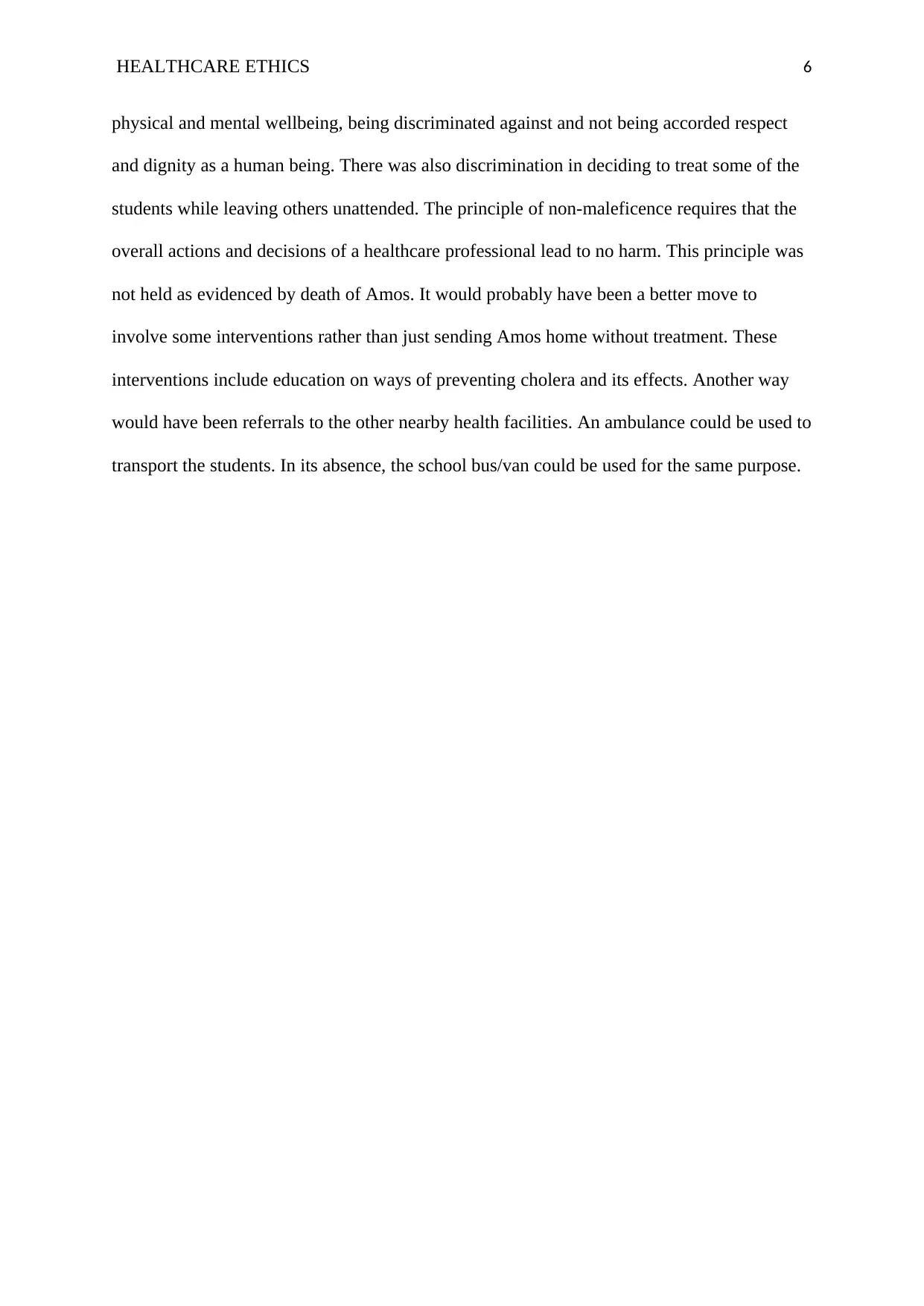
HEALTHCARE ETHICS 6
physical and mental wellbeing, being discriminated against and not being accorded respect
and dignity as a human being. There was also discrimination in deciding to treat some of the
students while leaving others unattended. The principle of non-maleficence requires that the
overall actions and decisions of a healthcare professional lead to no harm. This principle was
not held as evidenced by death of Amos. It would probably have been a better move to
involve some interventions rather than just sending Amos home without treatment. These
interventions include education on ways of preventing cholera and its effects. Another way
would have been referrals to the other nearby health facilities. An ambulance could be used to
transport the students. In its absence, the school bus/van could be used for the same purpose.
physical and mental wellbeing, being discriminated against and not being accorded respect
and dignity as a human being. There was also discrimination in deciding to treat some of the
students while leaving others unattended. The principle of non-maleficence requires that the
overall actions and decisions of a healthcare professional lead to no harm. This principle was
not held as evidenced by death of Amos. It would probably have been a better move to
involve some interventions rather than just sending Amos home without treatment. These
interventions include education on ways of preventing cholera and its effects. Another way
would have been referrals to the other nearby health facilities. An ambulance could be used to
transport the students. In its absence, the school bus/van could be used for the same purpose.
⊘ This is a preview!⊘
Do you want full access?
Subscribe today to unlock all pages.

Trusted by 1+ million students worldwide
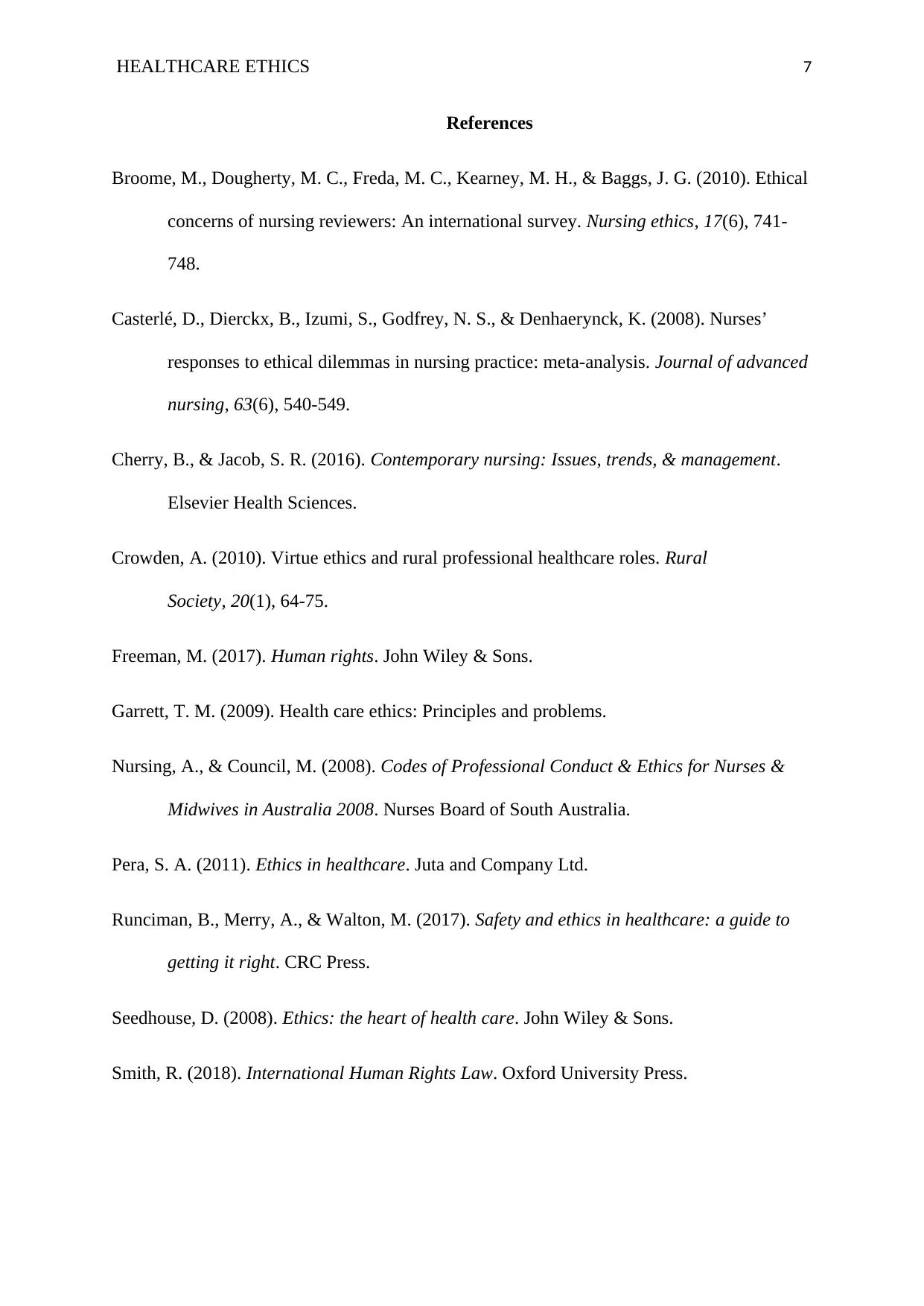
HEALTHCARE ETHICS 7
References
Broome, M., Dougherty, M. C., Freda, M. C., Kearney, M. H., & Baggs, J. G. (2010). Ethical
concerns of nursing reviewers: An international survey. Nursing ethics, 17(6), 741-
748.
Casterlé, D., Dierckx, B., Izumi, S., Godfrey, N. S., & Denhaerynck, K. (2008). Nurses’
responses to ethical dilemmas in nursing practice: meta‐analysis. Journal of advanced
nursing, 63(6), 540-549.
Cherry, B., & Jacob, S. R. (2016). Contemporary nursing: Issues, trends, & management.
Elsevier Health Sciences.
Crowden, A. (2010). Virtue ethics and rural professional healthcare roles. Rural
Society, 20(1), 64-75.
Freeman, M. (2017). Human rights. John Wiley & Sons.
Garrett, T. M. (2009). Health care ethics: Principles and problems.
Nursing, A., & Council, M. (2008). Codes of Professional Conduct & Ethics for Nurses &
Midwives in Australia 2008. Nurses Board of South Australia.
Pera, S. A. (2011). Ethics in healthcare. Juta and Company Ltd.
Runciman, B., Merry, A., & Walton, M. (2017). Safety and ethics in healthcare: a guide to
getting it right. CRC Press.
Seedhouse, D. (2008). Ethics: the heart of health care. John Wiley & Sons.
Smith, R. (2018). International Human Rights Law. Oxford University Press.
References
Broome, M., Dougherty, M. C., Freda, M. C., Kearney, M. H., & Baggs, J. G. (2010). Ethical
concerns of nursing reviewers: An international survey. Nursing ethics, 17(6), 741-
748.
Casterlé, D., Dierckx, B., Izumi, S., Godfrey, N. S., & Denhaerynck, K. (2008). Nurses’
responses to ethical dilemmas in nursing practice: meta‐analysis. Journal of advanced
nursing, 63(6), 540-549.
Cherry, B., & Jacob, S. R. (2016). Contemporary nursing: Issues, trends, & management.
Elsevier Health Sciences.
Crowden, A. (2010). Virtue ethics and rural professional healthcare roles. Rural
Society, 20(1), 64-75.
Freeman, M. (2017). Human rights. John Wiley & Sons.
Garrett, T. M. (2009). Health care ethics: Principles and problems.
Nursing, A., & Council, M. (2008). Codes of Professional Conduct & Ethics for Nurses &
Midwives in Australia 2008. Nurses Board of South Australia.
Pera, S. A. (2011). Ethics in healthcare. Juta and Company Ltd.
Runciman, B., Merry, A., & Walton, M. (2017). Safety and ethics in healthcare: a guide to
getting it right. CRC Press.
Seedhouse, D. (2008). Ethics: the heart of health care. John Wiley & Sons.
Smith, R. (2018). International Human Rights Law. Oxford University Press.
Paraphrase This Document
Need a fresh take? Get an instant paraphrase of this document with our AI Paraphraser
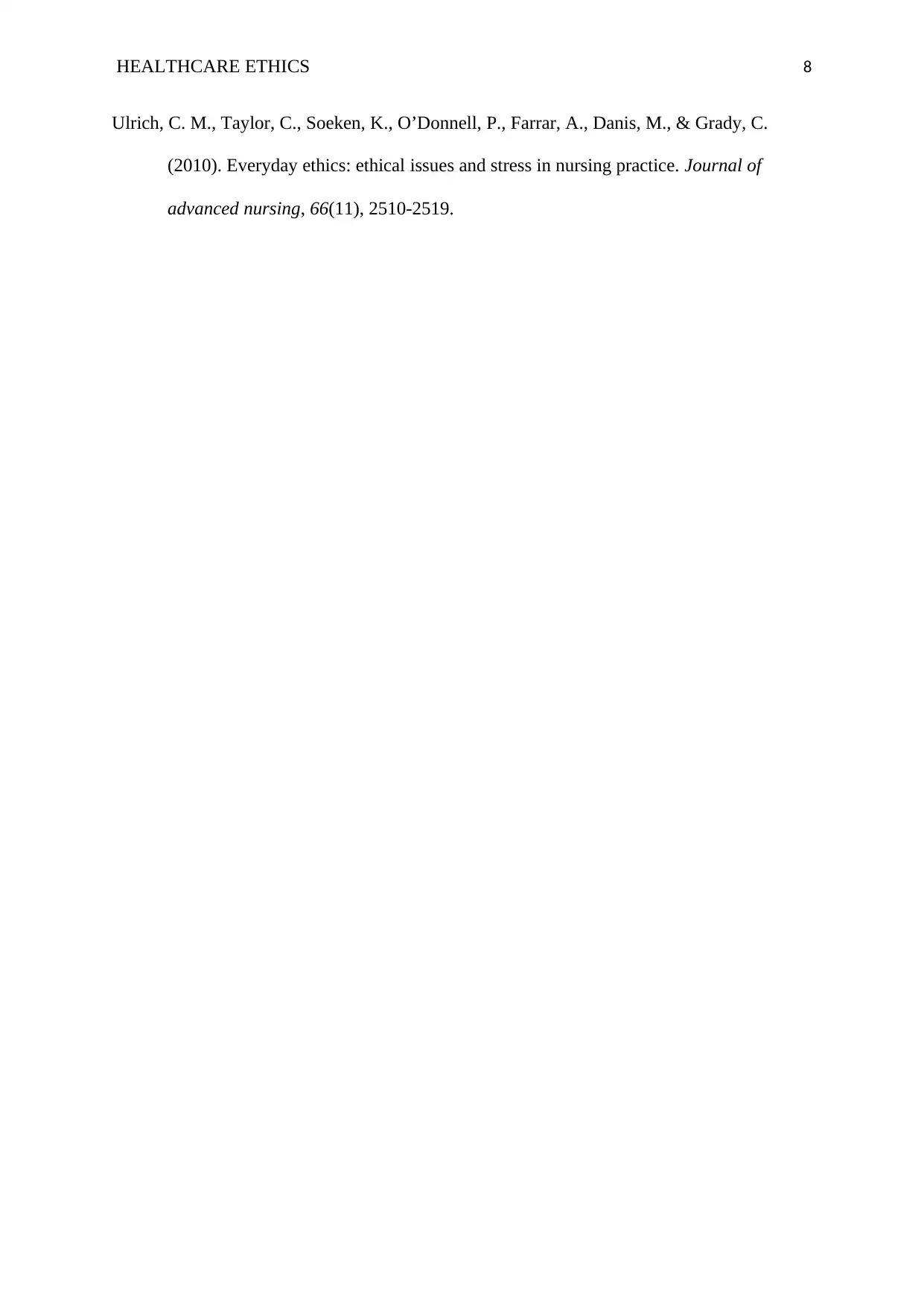
HEALTHCARE ETHICS 8
Ulrich, C. M., Taylor, C., Soeken, K., O’Donnell, P., Farrar, A., Danis, M., & Grady, C.
(2010). Everyday ethics: ethical issues and stress in nursing practice. Journal of
advanced nursing, 66(11), 2510-2519.
Ulrich, C. M., Taylor, C., Soeken, K., O’Donnell, P., Farrar, A., Danis, M., & Grady, C.
(2010). Everyday ethics: ethical issues and stress in nursing practice. Journal of
advanced nursing, 66(11), 2510-2519.
1 out of 8
Related Documents
Your All-in-One AI-Powered Toolkit for Academic Success.
+13062052269
info@desklib.com
Available 24*7 on WhatsApp / Email
![[object Object]](/_next/static/media/star-bottom.7253800d.svg)
Unlock your academic potential
Copyright © 2020–2025 A2Z Services. All Rights Reserved. Developed and managed by ZUCOL.





